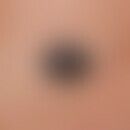Synonym(s)
HistoryThis section has been translated automatically.
DefinitionThis section has been translated automatically.
Today rare, lice-transmitted rickettsiosis leading to severe, systemic, often lethal vasculitis. Obligation to report!
You might also be interested in
PathogenThis section has been translated automatically.
EtiopathogenesisThis section has been translated automatically.
ClinicThis section has been translated automatically.
- Incubation period: 7-14 days. After unspecific prodromi (headache, fatigue) follows a high fever continuum with somnolence.
- Integument: On the 3rd to 6th day after onset of the disease, the appearance of variously sized, sometimes confluent, pale red to bluish roseoles, which spread from the upper to the lower part of the trunk and to the extremities. Involvement of Palmae and Plantae. Partially punctiform haemorrhages in the centre of the roseoles. Facies typhosa: Livid reddened face. Also pediculosis corporis.
- Neurological symptoms: muscle twitching, pressure sensitivity of peripheral nerves, motor restlessness. Hypotensive hypertension crises. Conjunctivitis, bronchitis, splenomegaly.
- If antibiotic therapy is not sufficiently prolonged, late relapses may occur in an attenuated form (so-called Brill-Zinsser's disease), but not after surviving untreated disease (lifelong immunity).
LaboratoryThis section has been translated automatically.
DiagnosisThis section has been translated automatically.
Differential diagnosisThis section has been translated automatically.
General therapyThis section has been translated automatically.
External therapyThis section has been translated automatically.
Internal therapyThis section has been translated automatically.
Initiate antibiotic treatment immediately upon suspicion, since the lethality rate is low with early therapy. The drug of choice is doxycycline (e.g. Doxycycline Heumann). In acute cases for adults 100 mg every 6-8 hours i.v. for 5-10 days until complete absence of fever and symptoms. In mild cases doxycycline 200 mg/day as a single dose.
In severe cases with incipient generalisation, additional glucocorticoids should be considered to counteract the toxic secondary symptoms, e.g. prednisolone (Decortin H) 100-125 mg/day i.v. for 2-3 days.
Progression/forecastThis section has been translated automatically.
Note(s)This section has been translated automatically.
Epidemic typhus and murine(endemic) typhus are clinically, pathologically and serologically similar. Human epidemic typhus was a human-louse-man cycle (heterogeneous-homonomous chain of infection) without an animal reservoir. This concept is now being challenged. Antibodies to R. prowazeki have been detected in farm animals in Africa, in rats in Manila, and in flying squirrels and humans in the United States. R. prowazeki has been recovered from blood samples of goats, sheep, from ixodid ticks, lice, and flea ectoparasites of flying squirrels, and from tissues of flying squirrels. More than 20 cases of acute epidemic typhus from flying squirrels have been reported in the United States. R. prowazeki has not been detected in human cases. Chemical studies of R. prowazeki and R. typhi show genetic similarities, but differences in genome size and degree of hybridization suggest that conversions between the two pathogens do not occur rapidly in nature. Their relationship is thought to become even closer over time (Woodward TE 1982)
LiteratureThis section has been translated automatically.
- Brill NE (1910) Acute infectious disease of unknown origin. A clinical study based on 221 cases. Am J Med Sciences 139: 484-502
- Coker C et al (2003) Development of Rickettsia prowazekii DNA vaccine: cloning strategies. Ann N Y Acad Sci 990: 757-764
- Fournier PE et al (2002) Human pathogens in body and head lice. Emerg Infect Dis 8: 1515-1518
- Ge H et al (2003) Genomic studies of Rickettsia prowazekii virulent and avirulent strains. Ann N Y Acad Sci 990: 671-677
- Lutwick LI et al (2001) Brill-Zinsser disease. Lancet 357: 1198-1200
- Massung RF et al (2001) Epidemic typhoid meningitis in the southwestern United States. Clin Infect Dis 32: 979-982
- Nicolle SH, Comte C, Conseil E (1909) Transmission experimentale du typhus exanthematique par pou du corps. CR Acad Sci 149: 486-489
- Nicolle SH, Comte C, Conseil E (1910) Experimental transmission of exanthematous typhus by body lice (Pediculus vestimenti). Ann Past Inst 24: 261-267
- Ricketts H (1909) A micro-organism which apparently has a specific relationship to Rocky Mountain spotted fever. J Am Med Soc 52: 379-380
Woodward TE (1982) Murine and epidemic typhus rickettsiae: how close is their relationship? Yale J Biol Med 55(3-4):335-41.
- Zinsser H (1934) Varieties of typhus virus and the epidemiology of the American form of European typhus fever (Brill's disease). Am J Hygiene 20: 513-532
Incoming links (8)
Brill-zinsser disease; Epidemic typhus; Epidemic typhus; Spotted lice fever; Spread of infectious diseases; Typhus, classic; Variegated typhus; Weil-felix reaction;Outgoing links (17)
Abdominal typhoid; Antibiotics; Brill-zinsser disease; Complement fixation reaction; Doxycycline; Epidemic typhus; Glucocorticosteroids systemic; Immunofluorescence; Obligation to notify; Paratyphoid; ... Show allDisclaimer
Please ask your physician for a reliable diagnosis. This website is only meant as a reference.




